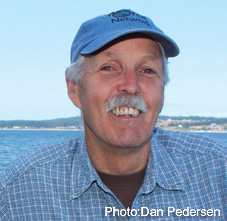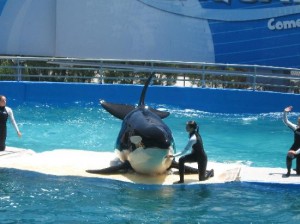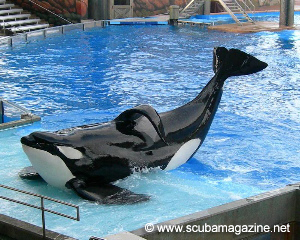How We Could Free Lolita!
 Can a captive dolphin be returned to the wild? In most cases, yes. Howard Garrett, director and co-founder of the Orca Network, explains how.
Can a captive dolphin be returned to the wild? In most cases, yes. Howard Garrett, director and co-founder of the Orca Network, explains how.
In 1995 Howard launched the campaign to return Lolita, from the Miami Seaquarium to her home waters in Puget Sound. Lolita is the last survivor of the orcas who were captured by the entertainment industry from the Southern Resident community.
ZOE: How long has Lolita been in captivity?
Howard Garrett: She was captured 40 years ago, and she’s been living in a tank at the Miami Seaquarium ever since. Her family is still out in the Pacific Northwest, but a lot of them were captured, too.
 For the first 10 years, she had a companion. We don’t know what their exact relationship was, but they came from the same community, so they used the same dialect and they could talk to each other.
For the first 10 years, she had a companion. We don’t know what their exact relationship was, but they came from the same community, so they used the same dialect and they could talk to each other.
ZOE: And you still believe she could be set free and returned to her family.
H.G.: Oh yes. Their family bonds last a lifetime. Orcas never leave their families. Even after 40 years of separation from her family, Lolita continues to call out in those calls that only her family uses back here in Washington. And they continue to use those calls to reaffirm their identity, as members of their own family.
ZOE: It’s heartbreaking to think that she’s stuck in a tank in Miami, 40 years later, still calling out to her family thousands of miles away in the Pacific Ocean.
H.G.: We call her family the Southern Resident Community. For six months or so of every year, they come into the inland waters here in Washington and British Columbia. They catch fish, they travel around, they navigate around the islands here.
And when the three pods meet up, they have bonding ceremonies, where they sort of reinforce, reaffirm those bonds between the pods. They have joyful celebrations. There’s a whole lot of mixing and merging across the pods, a lot of aerial acrobatics, a lot of cart-wheeling, breeching, spy-hopping, rolling around on the surface with one another. It’s not foraging. It’s not your textbook wildlife behavior. It’s very much a playful get-together.
ZOE: Even after 40 years, Lolita could be returned to her family? You’re still campaigning for that?
H.G.: I think that’s very reasonable, yes. I wouldn’t bet her life on it, but you don’t have to because she can have a choice. She and her family can have the opportunity to either come together and she could rejoin them and swim away with them. Or there could be a permanent care station available to her at all times so she can come back and be taken care of if that’s what she chooses. It wouldn’t be forced upon her, but I do believe she would ultimately rejoin her family, yes.
ZOE: How would that work?
H.G.: There’s a nice little bay there called Canaca Bay, where, in fact, two orcas were housed for 60 days in 1976. They were the last two captured, and by court-order, SeaWorld was not allowed to take them. Instead, they were released after being fitted with radio tags. But for 60 days they were in this little bay that was netted off. So Lolita could be returned there, too, and a whole care station could be set up, with food, veterinary care, attention and companionship. Her family would typically be coming by any time from late April into October, and they would inevitably hear each other and then we would see.
ZOE: It sounds a little bit like introducing a new dog to the family at home, when you keep them on the other side of the door where they can sniff each other, make noises and so on. When they’re comfortable and well acquainted, you open the door so they can meet each other.
H.G.: Right. It would all be done with veterinarians and people making sure that she’s ready. But there’s never been any kind of aggression within the family. That wouldn’t be expected. There’s no reason to think that there wouldn’t be recognition, and then it would be just a matter of her physical ability to keep up with them and to catch food – although they do typically share their food with one another, so even if she had to regain those skills, she would probably be taken care of in the meantime. Or she could always return to the care station, because they stay in that neighborhood for months, so she could gradually rebuild her strength and return for a bite to eat if she needed it.
Could Tilikum be freed?

ZOE: Well, that brings us to the subject of Tilikum, the whale who killed one of the trainers at SeaWorld. Could he be returned to his family, too?
H.G.: Hmm … a few things would have to take place for that to work. First off, he could be retired, and he could be placed into the same kind of a netted-off cove with a care station and be cared for in a natural environment, even if he couldn’t go out into the ocean. That would be fail-safe; there’s no reason not to do that.
But, his family would need to be located. He was captured in 1982 and I don’t think the family that he was captured from has been located. They would need to be located just to make sure that he was placed in their proximity so that they would have that opportunity to communicate.
But there could be other problems with Tilikum because he is exhibiting some very strange behavior. You sort of have to resort to the terms that we use for humans, which would be neurotic, if not psychotic. Obsessive, I would say. He’s messed up. He’s been driven to the edge of insanity by his extreme isolation.
Lolita at least gets trainers, and they’re kind of revolving door trainers, they come and go. Tilikum has other orcas around; but he is socially isolated from them because he’s a male from presumably a different community, different family. Because he’s killed people, nobody will go near him now.
I think Dawn Brancheau (the trainer he killed) took some real risks. I think she was showing a lot of compassion and a lot of attempts to try to make him feel better, but he just showed how crazy he was. Whether he would be able to be rehabbed, and whether his natural habitat and maybe the sounds and sights and company of his family would heal him — that’s an open question. I don’t know.
ZOE: The other thing is he doesn’t come from somewhere close by the U.S. or Canada. He came out of Icelandic waters somewhere. So I guess the routine that you were describing for Lolita, putting her in a cove somewhere with a net and so on might not apply.
H.G.: Right. We just don’t really know anything about where his family might be from time to time – which whales they would be. That would have to be done by matching acoustics, assuming that he makes calls now. Keiko did and Lolita does. Even after decades, they still make those calls. Then the family would have to be located, if they survived. A lot of them – about 100 orcas – were removed, and it’s possible that most of his family was as well. But that was only 30 years ago at most. Females can live into their 50’s, 60’s, 70’s, and beyond. So, chances are his mother, his maternal family, would at least partly still be alive.
A better way to learn from dolphins
ZOE: Is there anything we can usefully learn from dolphins who are kept in captivity?
H.G.: No. There was work done many years ago that affirms the intelligence of dolphins and their ability to communicate using symbols. That’s done, however, and there are other ways to do it. We could befriend dolphins in the wild and teach them to use these symbols as well, without taking them captive.
ZOE: How would you go about doing that in the wild?
H.G.: There are several cases of solitary, sociable dolphins around the world. Orcas who had become separated from their families and were obviously trying to have companionship with humans. But there is a prevailing ethic in the scientific and even the conservation communities to turn your back on them, to refuse to give them the companionship that they’re obviously seeking just to try to encourage them to go back and find their own kind. I think that is short-sighted. I think they’re looking for companionship and I think that a few designated people who are well-trained and educated should offer themselves as companions. We could regenerate a very strong relationship. That’s what happened with Keiko. When he arrived in Norway, he began to draw a crowd. But they wanted to control the crowds, so they led him away to a very remote location far in the north of Norway, and that’s where he died. I understand the crowd-control problem, but they over-reacted and just forbade all human contact with him.
You couldn’t just pick a dolphin out of the ocean and do it, but when there’s one who seeks out human interaction, then all kinds of fun games could be played with the whale or dolphin that involve symbols and all kinds of understanding of grammatical rules and syntax. It would be fun all the way around. It would show us just as much as any of the captive dolphin experiments showed us.
ZOE: What would need to be done to make this possible?
H.G.: It’s not so much laws. It’s more a conventional wisdom in the scientific community, which is the idea that whales and dolphins become habituated. It’s true of most other animals that if you feed them and befriend them, then they’re not likely to want to go back into the wild and try to find a family and fend for themselves. But with whales and dolphins, they have such an elevated awareness of themselves and their whole situation that they don’t forget who they are and where they belong. They have very deep family bonds and companionship. I mean, for orcas, it’s extreme. They just cannot live without that. Those family bonds last a lifetime. Orcas never leave their families.
What we humans could learn from orcas
ZOE: What’s one thing you want people to know about orcas?
H.G.: There’s a paper that was published in 2001 called Culture in Whales & Dolphins by Luke Rendell and Hal Whitehead. It says that orcas have a capability for culture that is without parallel except in humans. In other words, they live in cultural communities as we do. So the way knowledge is coming out now, orcas should be considered as nomadic tribes. Very much like we consider ethnic human communities, they are ethnic orca communities. I think that’s a real paradigm shift in how we see them and how we treat them.
ZOE: That would be something of a first, wouldn’t it?
H.G.: It would, and I think they’ve earned it. Dolphins have been around for about 8 to10 million years in their present form. They’ve had a lot more time to learn how to act as self-aware individuals and community members. They seem to show that they don’t kill each other. There’s almost no aggression between them in their own species. That’s what’s so fascinating. I know it’s extremely challenging to our beliefs.
ZOE: Do you think the folks at SeaWorld know just how miserable a situation it is for dolphins in captivity?
H.G.: They have a tremendous capacity for self-deception.
~~~~~~~~~~~~~~~~~~~~~~~~~~~~
The Orca Network is a 501(c)(3) non-profit, dedicated to raising awareness about the whales of the Pacific Northwest, and the importance of providing them healthy and safe habitats. This includes bringing back the salmon, cleaning up the waters, reducing noise pollution. It sends regular news by e-mail to more than 4,000 people with first-person reports from people who see whales. The network is supported by private donations (generally $25 – $100) and the occasional grant to conduct specific studies.
The Orca Network also provides educational presentations for school students and community organizations, gives naturalist talks on the ferries, develops educational materials, and designs and maintains the Orca Network website.
